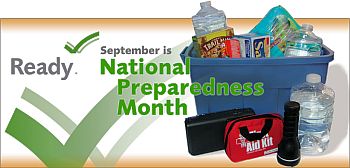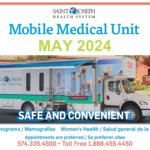 09/12/12 As part of National Preparedness Month, the Indiana State Department of Health has launched a “30 Days, 30 Ways to Prepare” campaign. The campaign provides daily tips categorized into a weekly theme for the month of September. The second week’s theme is focused on how to build an emergency kit.
09/12/12 As part of National Preparedness Month, the Indiana State Department of Health has launched a “30 Days, 30 Ways to Prepare” campaign. The campaign provides daily tips categorized into a weekly theme for the month of September. The second week’s theme is focused on how to build an emergency kit.
An emergency kit is a supply of items your household may need in the event of a disaster. When putting your emergency kit together, include enough supplies to meet the needs of you and your family for at least three days. Take the time now to assess your situation and ask questions.
Your emergency toolkit should include:
- An emergency contact card. Include an out of-town contact on your contact card. It may be easier to reach someone out of town if local phone lines are out of service or overloaded.
- A first aid kit. Antibiotic cream and bandages will be useful to treat minor cuts and bruises and help prevent infection.
- At least one change of clothing. Include at least one complete change of clothing and footwear per person in your emergency supply kit. It’s advised to pack long pants and long sleeves for additional protection after a disaster.
- Non-perishable food items. Stashing away an extra supply of non-perishable food items can save your life. Be sure to stock up on food your family already likes and include one gallon of water per person per day.
- Flashlights and batteries. Flashlights that don’t require batteries are also available; just shake them or turn a crank.
- Cash. If the electricity is out, ATMs and credit card machines won’t work. Keep some extra cash in your emergency kit for essentials like food and gasoline.
A disaster can cause significant financial loss. Your apartment or home may be severely damaged or destroyed, along with important financial records. You may be forced to live in temporary housing; income may be cut off or significantly reduced. Consider using the Emergency Financial First Aid Kit (EFFAK), a tool developed by Operation Hope, FEMA and Citizen Corps or contact your local Red Cross chapter for Disasters and Financial Planning: A Guide for Preparedness.
Have a plan for your pets too. Think about including food, water, litter, treats, favorite toy, bed, and cage. Animals can be just as distressed as you if a disaster hits their home.
To view the daily preparedness tips, visit the Indiana State Department of Health’s website at www.StateHealth.in.gov. For more information about National Preparedness Month, visit the Federal Emergency Management Agency’s website at http://www.ready.gov/.














